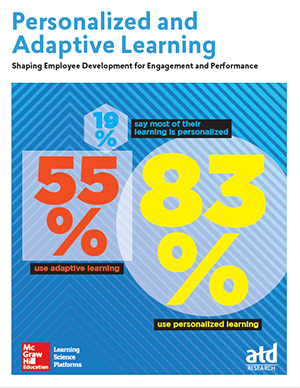
The Two Critical Things L&D Professionals Need to Make Personalized and Adaptive Learning Work
These days, a one-size-fits-all approach to organizational learning is out the window. That puts the onus on talent development functions to provide the kind of engaging and fast-paced training (think TED Talks and YouTube) employees are used to accessing in their personal lives. Learning and organizational performance and agility demand it.
How is L&D (learning and development) responding to the challenge?
According to the latest collaborative research from i4cp and ATD, personalized and adaptive learning are playing big (and soon to be bigger) roles in delivering compelling and relevant content that’s uniquely tailored to employees’ learning needs and preferences. Personalization tailors learning to individuals based on such factors as their job roles, learning pace, preferred learning methods, and the like.

The study, Personalized and Adaptive Learning: Shaping Employee Development for Engagement and Performance, reports that 83% of surveyed L&D leaders already are personalizing at least some of the training assets their departments offer.
Fewer (52%) are making adaptive learning available, but the research found both approaches poised for significant growth in the next year or two.
In particular, adaptive learning—defined as “personalized learning that uses computer-based technology to modify content to a learner’s needs”—is projected to expand, in large part due to expected growth in the use of artificial intelligence (AI). Technologies leveraging AI enable learning to adapt in real time based on the behaviors and interactions of learners.
Dan Lovely, former chief learning officer of AIG and thought leader in the personalized and adaptive learning space, says that personalizing learning provides a “huge opportunity to affect business performance in a far more impactful way,” though he adds that L&D practitioners “have much to learn if that promise is to be realized.”
Study findings suggest two critical areas of upskilling for talent development professionals:
- Understanding and use of technologies underlying personalized and adaptive learning
- Corresponding upgrades in instructional design skills.
The research confirmed that market-leading companies, which report greater effectiveness in using personalized and adaptive learning, implement those approaches differently—especially when compared with organizations that don’t achieve similar performance and learning success. Differentiators were discovered in high-performers’ motivations, their design practices, and the audiences and types of learning they chose for personalized and adaptive interventions.
With significant growth in personalized learning anticipated, and use of adaptive learning—and AI to drive it—projected to triple in the next two years, there’s no better time for learning and business leaders to explore implementing or expanding these development strategies. Start today by downloading the white paper on Personalized and Adaptive Learning: Shaping Employee Development for Engagement and Performance .
For a deeper dive, a report of the full study is available for purchase from ATD.
